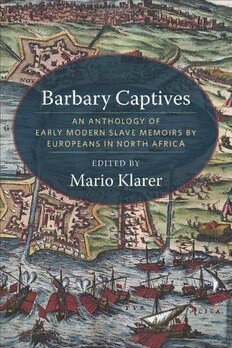
Barbary Captives: An Anthology of Early Modern Slave Memoirs by Europeans in North Africa PDF
Preview Barbary Captives: An Anthology of Early Modern Slave Memoirs by Europeans in North Africa
BARBARY CAPTIVES Barbary Captives AN ANTHOLOGY OF EARLY MODERN SLAVE MEMOIRS BY EUROPEANS IN NORTH AFRICA Mario Klarer Columbia University Press New York Columbia University Press Publishers Since 1893 New York Chichester, West Sussex cup.columbia.edu Copyright © 2022 Columbia University Press All rights reserved Library of Congress Cataloging-in-Publication Data Names: Klarer, Mario, 1962– editor. Title: Barbary captives : an anthology of early modern slave memoirs by Europeans in North Africa / Mario Klarer. Description: New York : Columbia University Press, [2022] | Includes bibliographical references and index. Identifiers: LCCN 2021033280 (print) | LCCN 2021033281 (ebook) | ISBN 9780231175241 (hardback) | ISBN 9780231175258 (trade paperback) | ISBN 9780231555128 (ebook) Subjects: LCSH: Slavery—Africa, North—History—Sources. | Captivity narratives— Africa, North. | Slaves—Africa, North—Biography—Sources. Classification: LCC HT1345 .B37 2022 (print) | LCC HT1345 (ebook) | DDC 306.3/620961—dc23 LC record available at https://lccn.loc.gov/2021033280 LC ebook record available at https://lccn.loc.gov/2021033281 Columbia University Press books are printed on permanent and durable acid-free paper. Printed in the United States of America Cover design: Milenda Nan Ok Lee Cover image: Engraving of early modern Tunis. Georg Braun and Frans Hogenberg, Civitates Orbis Terrarum, vol. 2 (Cologne, 1575), Mario Klarer, private collection. For Marjorie Perloff Contents Preface ix Acknowledgments xiii Introduction 1 Narratives i Balthasar Sturmer, Account of the Travels of Mister Balthasar Sturmer (1558 German manuscript; captivity in Tunis 1534–1535; complete text) 51 ii Antonio de Sosa, Topography of Algiers: Attempted Escape of Miguel de Cervantes (1612 Spanish print edition; captivity in Algiers 1577; selection) 91 iii Ólafur Egilsson, The Travels of Reverend Ólafur Egilsson (undated Icelandic manuscripts; Icelandic raid and captivity in Algiers 1627–1628; selection) 101 iv Emanuel d’Aranda, Short Story of My Unfortunate Journey (undated Dutch manuscript; captivity in Algiers 1640–1641; complete captivity narrative) 117 v Antoine Quartier, The Religious Slave and His Adventures (1690 French print edition; captivity in Tripoli 1660–1668; selection) 161 [ vii ] vi Andreas Matthäus and Johann Georg Wolffgang, Travels and Wonderful Fortunes of Two Brothers in Algerian Bondage (1767 German print edition; captivity in Algiers 1684–1688; complete text) 187 vii Isaac Brassard, The Tale of Mr. Brassard’s Captivity in Algiers (1878 French print edition; captivity in Algiers 1687–1688; complete captivity narrative) 201 viii Thomas Pellow, The History of the Long Captivity and Adventures of Thomas Pellow ([1740?] British print edition; captivity in Morocco 1715–1738; selection) 211 ix Hark Olufs, The Remarkable Adventures of Hark Olufs (1747 Danish print edition; captivity in Constantine 1724–1735; complete text) 233 x Maria ter Meetelen, Miraculous and Remarkable Events of Twelve Years of Slavery (1748 Dutch print edition; captivity in Morocco 1731–1743; selection) 255 xi Marcus Berg, Description of the Barbaric Slavery in the Kingdom of Fez and Morocco (1757 Swedish print edition; captivity in Morocco 1754–1756; selection) 281 xii Elizabeth Marsh, Narrative of Elizabeth Marsh’s Captivity in Barbary (undated British manuscript; captivity in Morocco 1756; complete captivity narrative) 307 xiii Felice Caronni, The Account of an Amateur Antiquarian’s Short Journey (1805 Italian print edition; captivity in Tunis 1804; selection) 339 Appendix: Selection of European and American Barbary Captivity Narratives 357 List of Works Cited and General Works on North African Piracy and Captivity 369 Index of Persons and Locations 389 [ viii ] CONTENTS Preface A bducted by pirates,1 sold on the slave market, and enslaved in North Africa—such was the fate of hundreds of thousands of Europeans, both male and female, in the early modern period. A large number of returnees from Muslim captivity on the “Barbary Coast,” as the North African shore was called, wrote and published accounts of their experiences.2 This anthology brings together, for the very first time, English translations of a selection of Barbary captivity narratives from nine different European regions and languages. The linguistic and geographic spectrum of these texts includes narratives in Spanish, Italian, French, German, Dutch, English, Danish, Swedish, and Icelandic. The diverse European national specimens of the Barbary captivity narrative also span three centuries, from the mid- sixteenth to the early nineteenth century, during which these texts assumed 1. pirate: in this anthology, the terms “corsair,” “pirate,” and “privateer” are used in a broad sense. While “corsair” and “privateer” usually refer to pirates operating with state sanction, it should be noted that the distinctions between these terms are often blurred by the authors of the early mod- ern narratives in this anthology. 2. Muslim captivity: in this anthology, the terms “Muslim captivity” and “North African captivity” are used in a broad sense and encompass persons who were captured by North African pirates, those who were sold in North African slave markets, those who were held for ransom (without necessar- ily having to work as slaves), and those who were forced into slave labor, among other things. For more on terminological aspects of captives and slaves, see Peter Mark, “ ‘Free, Unfree, Captive, Slave’: António de Saldanha, a Late Sixteenth-Century Captive in Marrakesh,” in Piracy and Captivity in the Mediterranean, ed. Mario Klarer (London: Routledge, 2019), 99–110. [ ix ]
